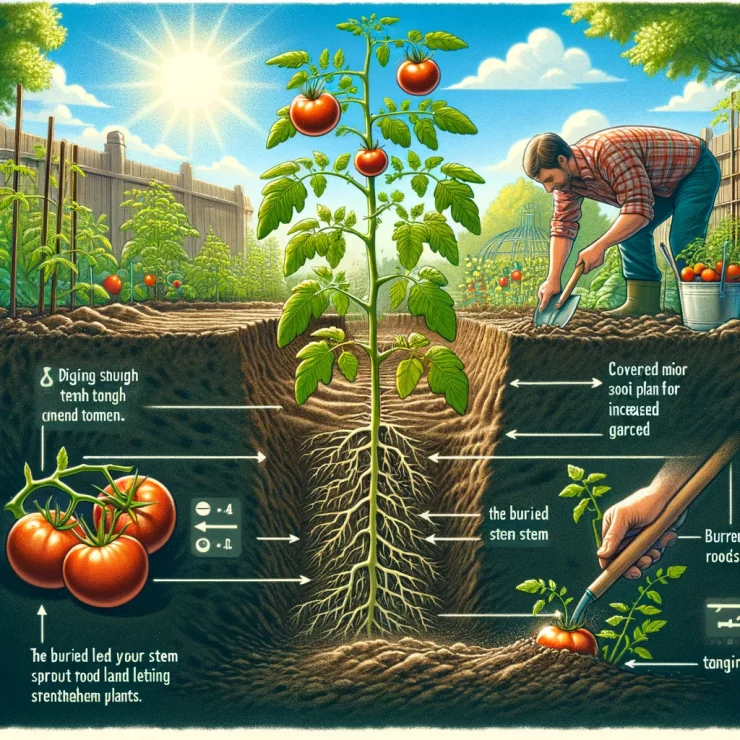Tomatoes are the darlings of the vegetable garden, cherished for their vibrant colors, succulent flavors, and versatility in culinary creations. However, coaxing the most abundant harvest from these plants requires more than just watering and sunlight. Enter the ingenious technique known as “trenching” tomatoes – a sideways planting method that promises to revolutionize your tomato-growing game and yield bountiful harvests.
Understanding the Trenching Technique
Traditional planting methods involve digging a hole and placing the tomato plant vertically into the soil. While effective, this approach might not utilize the plant’s full potential. Trenching, on the other hand, flips this conventional wisdom on its head by laying the tomato plant sideways into a shallow trench rather than upright. This simple adjustment can lead to stronger root systems, increased nutrient absorption, and ultimately, larger yields.
The Benefits of Trenching
Root Development: Trenching encourages robust root development. By planting tomatoes sideways, more stem surface area comes into contact with the soil, allowing for the emergence of additional roots along the stem. This expanded root network enhances the plant’s ability to absorb water and nutrients, leading to healthier growth.
Moisture Retention: In regions prone to drought or inconsistent watering, trenching can be a game-changer. Because the plant is positioned horizontally, the soil covering the buried stem acts as a natural reservoir, helping to retain moisture during dry spells and reducing the frequency of watering needed.
Stability and Support: Trenching provides greater stability for the tomato plant. As it grows, the buried stem develops into a sturdy anchor, anchoring the plant securely in place. This added support is particularly advantageous for indeterminate varieties, which tend to sprawl and benefit from additional structural support.
Improved Nutrient Uptake: By positioning the plant closer to the soil’s nutrient-rich layers, trenching facilitates better nutrient uptake. As the buried stem decomposes over time, it releases organic matter and nutrients directly into the root zone, providing a steady supply of nourishment throughout the growing season.
How to Trench Tomatoes: A Step-by-Step Guide
Prepare the Trench: Begin by digging a trench that is approximately 6-8 inches deep and long enough to accommodate the length of the tomato plant. The trench should be wide enough to allow for easy placement of the plant.
Lay the Tomato Plant Sideways: Gently remove the tomato plant from its container or carefully loosen the roots of a seedling. Then, lay the plant horizontally in the trench, ensuring that the stem is fully covered with soil while the top foliage remains above ground.
Backfill and Water: Once the plant is in position, carefully backfill the trench with soil, pressing it firmly around the stem to provide stability. Water the newly planted tomato thoroughly to settle the soil and ensure adequate moisture around the roots.
Provide Support: As the tomato plant grows, provide support using stakes or a trellis system to prevent sprawling and promote upright growth. Regularly check the ties to ensure they are not constricting the plant as it expands.
Mulch and Maintain: Apply a layer of organic mulch around the base of the tomato plant to conserve moisture, suppress weeds, and regulate soil temperature. Additionally, monitor the plant for signs of pests or disease and address any issues promptly to maintain optimal health and productivity.
Trenching tomatoes may seem unconventional at first glance, but its benefits are undeniable. By harnessing the power of sideways planting, gardeners can unlock the full potential of their tomato plants and enjoy abundant harvests season after season. Whether you’re a seasoned gardener or a novice enthusiast, consider incorporating this innovative technique into your gardening repertoire for a truly fruitful experience. With “trenching,” the path to plump, juicy tomatoes has never been more promising.






Add comment